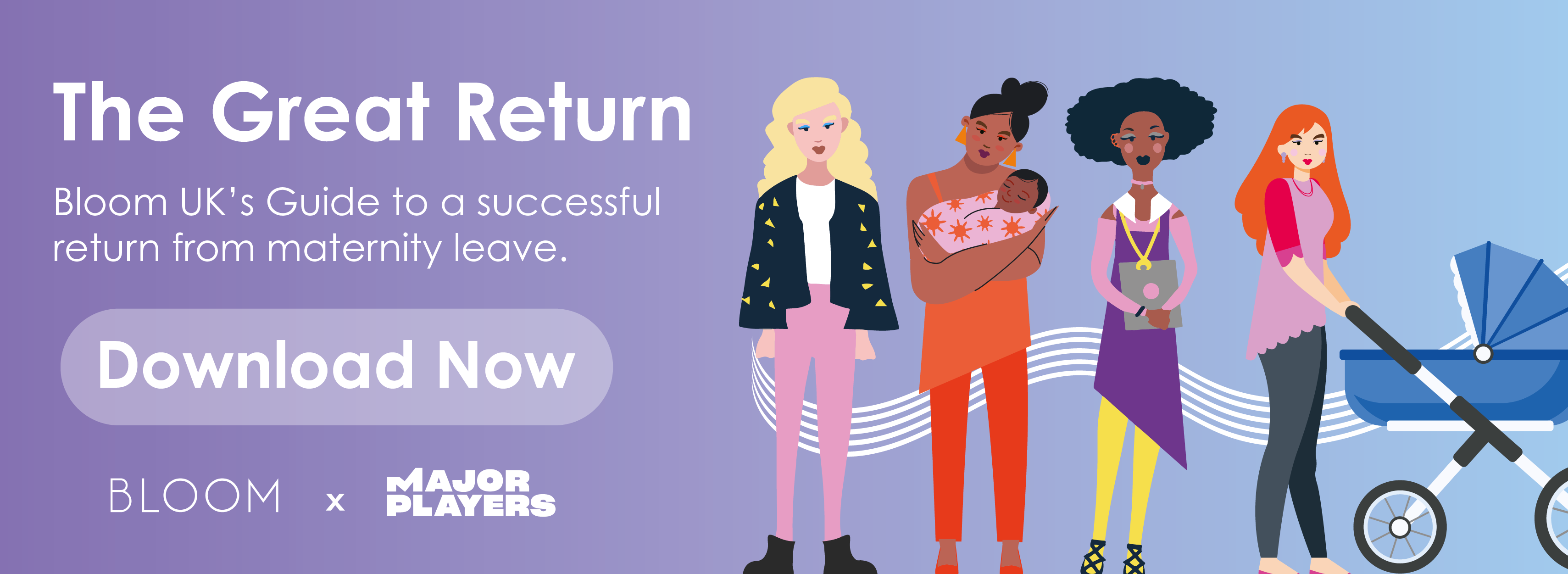.png)
Bloom is a 500-member strong professional network for women in communications where every member is effectively a volunteer. It exists to drive change, with a particular mission to enable gender equality in the industry.
Kate Moss, business manager at Major Players, sat down with Zara Gregory, global business director at Anomaly London, and author of Bloom’s maternity leave playbook, The Great Return, to find out more about Bloom and its new guide.
Zara, tell me more about Bloom and the work you do
I’ve been a member of Bloom since 2020 and have loved every minute. It is all about championing the real voices of women and so much of what I do is about finding my own voice, whilst also helping others to be heard. The maternity leave guide is a great example of that - it is powered by the real voices and experiences of mothers in our industry.
All of Bloom’s members mentor junior women in the industry, and across the network we run events like BloomFEST, we offer workshops, create podcasts and even run The Exchange - a brilliant cross-mentoring programme matching senior men and senior women - all to support that end goal of gender equality.
What is The Great Return guide about and why did you feel compelled to author it?
The Great Return is a practical guide covering the run up to maternity leave, during it and the actual return. It’s aimed primarily at employers to offer insight into how an employee coming to, on or returning from maternity leave may feel, and give practical suggestions for how to fuel a positive and successful return.
When I returned from maternity leave myself, a manager asked me to help them understand what someone returning needed. And the question really stuck with me. She made an excellent point: how can we expect managers and colleagues to magically know what to do?
And yet returning from maternity leave is a huge potential moment for talent drop off. If we’re serious about retaining our maternal talent and unlocking its full potential, we need to better equip those who are managing returning mothers.
Can you share what you think are some of the most important points from the guide?
Prior to writing the guide, we ran an industry-wide survey inviting mothers to share their maternity leave and return experiences. The data was fascinating. It gave us a window into the worry and anxiety felt by women announcing a pregnancy in the first place. Over half (58%) of first-time mums said they felt worried, rising to 73% of second-time mums. And sadly, a quarter of mums surveyed said they were ‘treated more negatively than expected’ post pregnancy announcement.
The survey revealed a direct correlation between a strong pre-leave approach and a positive return experience. As well as the fact that two out of three mums received no return-to-work initiatives, not even free things such as a thorough handover.
Whilst the guide shows the work needed, it also shows the very real benefits of getting it right. Employees who had a negative return experience were 63% more likely to leave the business within six months of returning. Yet over half of returners with positive return experiences were still with their companies over three years later.
What kind of challenges do you think employers might face when looking to implement the guidance?
It can be hard trying something new. With the guide we are asking employers to do all they can to foster empathy in their business, but also make arrangements that are more likely to make a return stick. From considering phased returns to encouraging all working parents in the business to be open about the realities of returning and/or working with young children – these are potentially new approaches that take some organising and rely on a culture where transparency is encouraged. It would be naïve to think that is easy for all employers and managers.
That said, the beauty of this guide is that the vast majority of suggestions are free. And some are not very time consuming at all. It’s more about being up for making a difference and trying to see things from a different perspective.
How can a great maternity leave experience benefit the employer?
A positive experience will encourage the talent to return to the business, which not only eliminates the financial and time costs involved with hiring new staff but should also lead to productivity and in turn profitability much sooner, than hiring a brand new employee.
Put simply, you will not only be more likely to retain your maternal talent, but you will unlock its full potential. That has commercial, creative and cultural benefits. It’s a no-brainer; save money on recruitment, strengthen your output as a business with more diverse inputs and fuel a more naturally inclusive culture.
How can employers take an authentic approach and ensure it’s not just a tick-box exercise?
A strong maternity leave approach is about so much more than the letter of the policy; it’s about an employer’s behaviours and underlying values. Actively listening to employees and really being open to learning something new and trying something different is key to an authentic approach.
Be there for your employees, all of them! Listen to their challenges and concerns and develop solutions that exhibit the fact you genuinely care.
Top tips to supercharge your maternity leave policy and processes:
- Consider small things that could make a big difference. After the mum-to-be announces their pregnancy, assess what office equipment could help make it more comfortable for them to work. Get them involved with sourcing cover and factor in time for a thorough handover. Ensure your social events are designed to be inclusive, send a gift when the baby is born, and invite those on leave to the major cultural get togethers.
- Ensure regular, clear and positive communication from the outset. Encourage the employee to use Keep In Touch (KiT) days in a way that suits you both. It can be a catch-up coffee, a half-day for inductions or part of a staggered return.
- Accommodate a phased and flexible return and don’t forget the basics such as thorough handovers, and introductions to new colleagues, clients, software and new business.
- Agree short-term developmental goals for the return: It can be overwhelming and this can be a tool to lend mutual focus and help celebrate key achievements.
- Offer guidance, mentoring and training, such as an internal parent mentor or buddy scheme, which can be a great support system for working parents in general.
Download your free copy here.










